Historic images of England
- Published
The photographic archive of Historic England contains images that capture 150 years of the changing social scene as well as the landscape of the country. An exhibition of pictures from the collection is on show until 21 September 2015 at Birmingham Library.

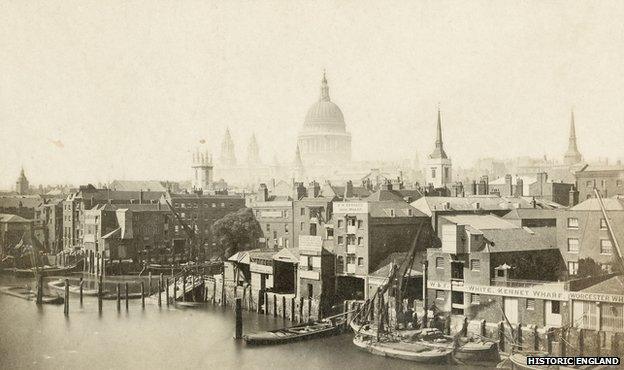
This view of St Paul's Cathedral looming beyond the Thames-side wharves is an albumen print from a wet collodion negative. The photographer is unknown, though it is virtually identical to a calotype photograph by Alfred Rosling and it is possible that he tried to recapture the scene later in the decade using the more up-to-date process. Rosling was a timber merchant and one of England's earliest amateur photographers and a founder member of the Photographic Society and the Photographic Exchange Club.
Photo: St Paul's Cathedral from Southwark Bridge, City of London 1855-59. Unknown photographer, possibly Alfred Rosling (1802-82)

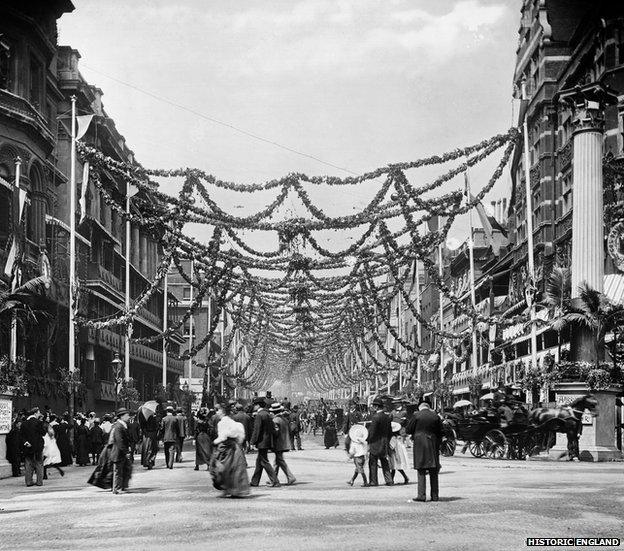
London photographers, York & Son, took this picture of the preparations to celebrate Queen Victoria's Diamond Jubilee. St James's Street is festooned with garlands and lights beyond a pair of mock classical columns. Many temporary structures were built in front of shops, offices and private dwellings along the processional route, and one agency, Francis Hope & Co, advertised seats and window views at prices ranging from two to 2,000 guineas.
Photo: Diamond Jubilee decorations, St James's Street, London 1897. York & Son


The collecting of seabirds' eggs from Flamborough Cliffs fascinated holidaymakers, and therefore attracted the attention of the Bradford-based postcard company Walter Scott Ltd. Tourist guidebooks described how teams of four would gather the eggs in late spring and early summer, lowering a climber over the edge of the cliff by rope and pulley. After collecting guillemot, razorbill, kittiwake and puffin eggs in bags attached to his waist, the climber would be pulled back to the cliff top. This image shows one successful team at "the end of a hard day".
Photo: Egg gatherers, Flamborough, East Yorkshire July 1926. Walter Scott Ltd

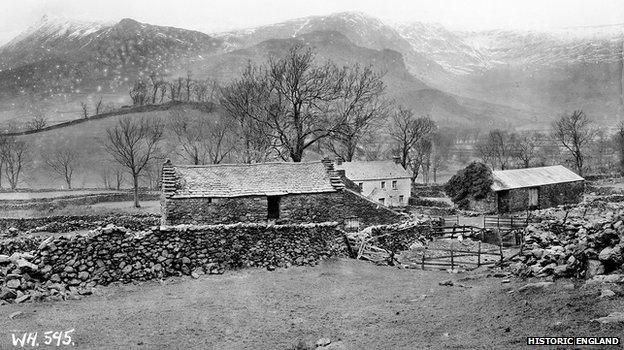
This photograph of Goosemire farmstead was taken during investigations for the Royal Commission on the Historical Monument of England's Westmorland Inventory, which was published in 1936. It soon became a valuable object of record as the construction of the Haweswater Dam to supply water to Manchester, beginning in 1929, dramatically changed the landscape of Mardale. Goosemire farmstead was demolished soon after this photograph was taken, and the dam later raised the level of the existing Haweswater Lake, flooding the valley. The very top of Wood Hawe, in the middle distance of the image, is now just above the waters.
Photo: Goosemire, Mardale, Cumbria 1935. Royal Commission on the Historical Monuments of England


Henry Taunt, the Oxford photographer, poses with a female companion, probably his housekeeper and friend Fanny Miles. Taunt photographed the River Thames from around 1860, eventually opting for this comfortable horse-drawn houseboat which served as a floating studio with a rooftop mounting for his camera.
Photo: Henry Taunt on his houseboat, Oxford, Oxfordshire, 1895. Unknown Photographer.

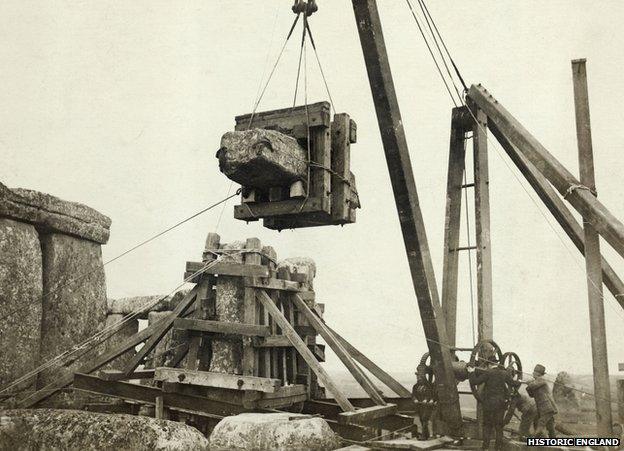
After many years in private ownership, Stonehenge was given to the nation in 1918, and a programme of investigation and restoration followed a structural survey by the Office of Works. The archaeologist Lt Col William Hawley supervised extensive works that included excavation, the righting of fallen stones, and remedial steps to prevent the collapse of others. Here a trilithon lintel is being replaced following the re-erection of Stones 6 and 7, and their setting in concrete. Hawley's restoration work came to an end in December 1920 but his excavations continued until 1926.
Photo: Lintel being lifted for replacement after adjustment of stones 6 and 7, Stonehenge, Wiltshire 17 March 1920. Office of Works.

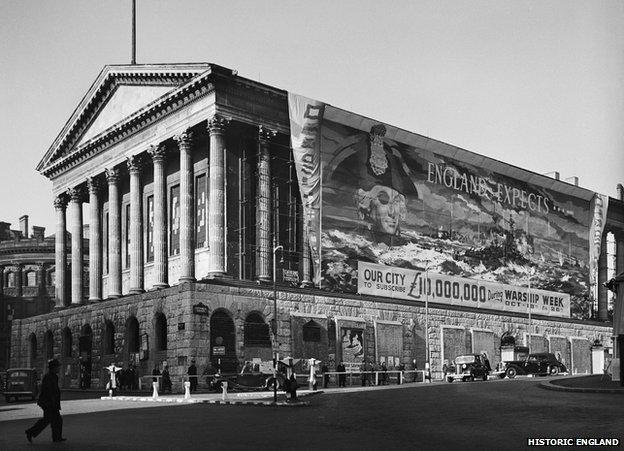
George Bernard Mason's wartime view of Birmingham Town Hall has captured the building festooned with an enormous graphic banner promoting a Nelson-inspired Warship Week fundraising campaign. The city's target was to raise £10m in savings for the adoption of the battleship HMS King George V. Sir John Summerson, one of the leading lights behind the formation of the National Buildings Record (NBR), in 1991, described Mason as "the greatest discovery and the champion producer of results of the highest competence". Mason, a Birmingham craftsman and part-time photographer, went on to take thousands of images for the NBR until the 1960s.
Photo: Birmingham Town Hall, Victoria Square, Birmingham 1941. George Bernard Mason (1896-1985), National Building Record.

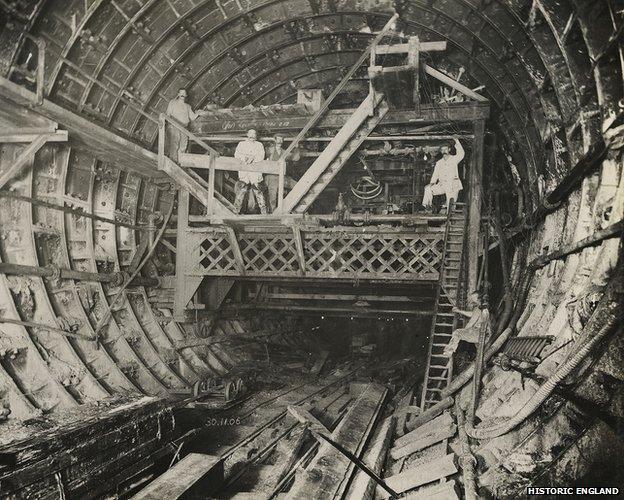
Begun in 1904, the construction of the Rotherhithe tunnel was supervised by Maurice Fitzmaurice, chief engineer to London County Council, who had worked on the earlier Blackwall Tunnel and used a similar structural design here. The road tunnel connected the dock areas of the Ratcliffe district of Limehouse north of the River Thames with Rotherhithe in the borough of Southwark to the south of the river. The Prince of Wales, later King George V, officially opened the tunnel on 21 June 1908.
Photo: Rotherhithe Tunnel under construction, Southwark, London 30 November 1906. Unkwown Photographer.

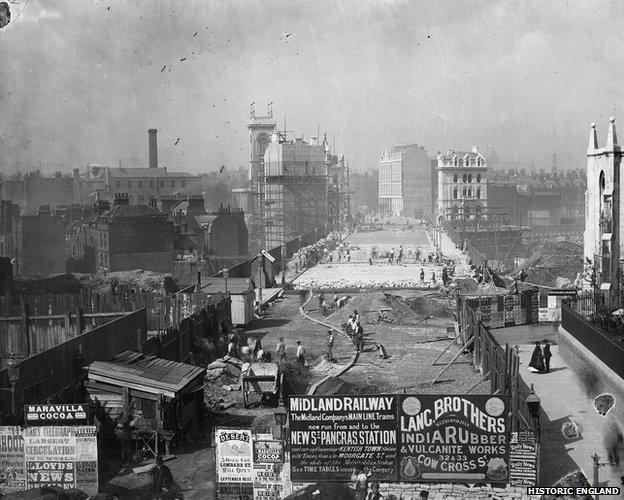
This elevated view of Holborn Viaduct under construction is one of a series of images taken by Henry Dixon to record progress on this Corporation of London improvement scheme. It shows the scale of a project which involved demolishing more than 4,000 buildings and provided a causeway over the Fleet Valley, connecting the West End with the City. A hoarding announces that Midland Railway mainline trains are using the new St Pancras Station. Henry Dixon took up photography before 1860, and is probably best known for his work for the Society for Photographing Relics of Old London.
Photo: The Holborn Viaduct under construction, City of London 11 September 1869. Henry Dixon (1820-93)

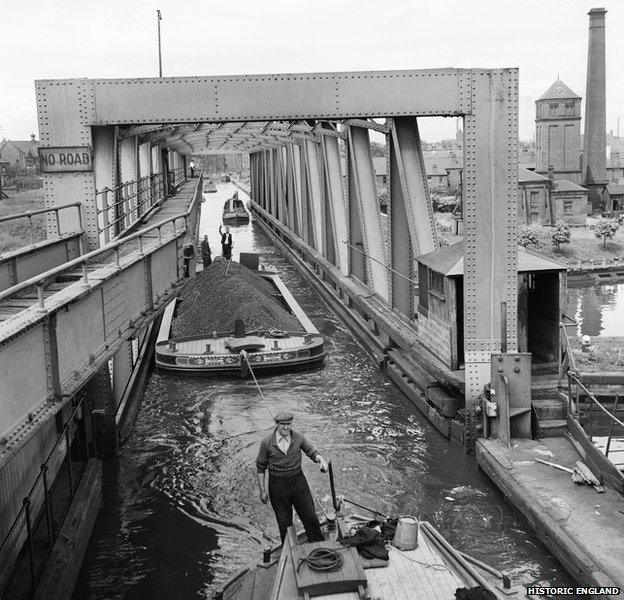
The aqueduct, designed by Sir E Leader Williams and built in 1893, was the first swing aqueduct to be constructed, using hydraulic power to turn the structure on a central pier to allow the passage of vessels below. It replaced the first canal aqueduct in England which opened in 1761 to carry the Duke of Bridgewater's Canal over the River Irwell. A 600-mile (965km) tour of England's inland waterways in 1948 inspired Eric de Mare, one of the most important industrial photographers of his generation, with an enthusiasm for canals.
Photo: Barton Swing Aqueduct, Bridgewater Canal, Trafford, Greater Manchester 1945-54 by Eric de Mare (1910-2002)


Alfred (1844-1926) and John Bool (1850-1933) of Pimlico, photographed the Oxford Arms Inn for the Society for Photographing Relics of Old London when the future of the building was uncertain.
Photo: Oxford Arms Inn, Oxford Arms Passage, Warwick Lane, City of London 1875. A&J Bool
There is a book to accompany the exhibition, Picturing England: The Photographic Collections of Historic England, published by Historic England.